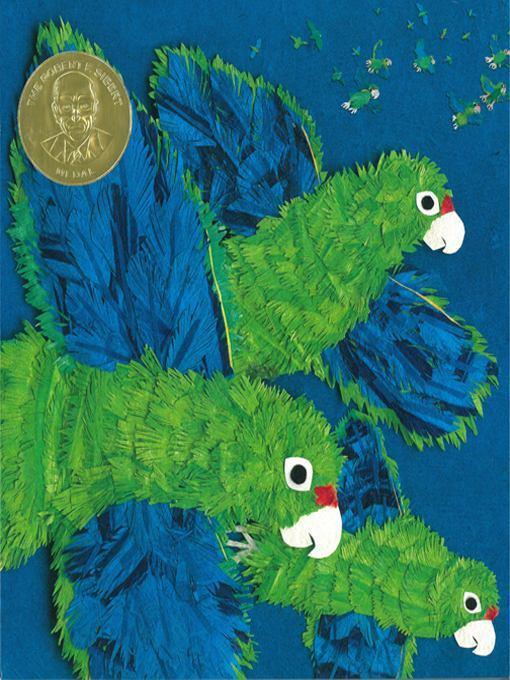
Parrots Over Puerto Rico
فرمت کتاب
ebook
تاریخ انتشار
2014
Lexile Score
890
Reading Level
4-5
ATOS
5.7
Interest Level
K-3(LG)
نویسنده
Susan L. Rothناشر
Lee & Low Booksشابک
9781620141779
کتاب های مرتبط
- اطلاعات
- نقد و بررسی
- دیدگاه کاربران
نقد و بررسی

Starred review from August 5, 2013
Parrots thrived in Puerto Rico long before the first human settlers arrived some 5,000 years ago; by 1975, only 13 of the birds were still living in the wild. Roth and Trumbore follow The Mangrove Tree with another story of ecological revitalization, explaining the threats the parrots faced over the centuries, including invasive species and deforestation. The authors demonstrate how the parrots’ survival was entwined with Puerto Rico’s very history (bees and rats from Spanish settlers’ ships wreaked havoc on the birds’ nests) before detailing ongoing efforts to rebuild their numbers. The book itself is oriented vertically, calendar-style, amplifying its sense of height and allowing for dramatic paper and fabric collages that show the vivid blue-and-green parrots soaring over the island. In an especially lovely scene, a towering waterfall of crinkled strips of white paper cascades over a fibrous backdrop of rocks in Puerto Rico’s El Yunque rainforest. An extensive afterword describes the species’ recovery and includes more than a dozen photographs. A thoughtful and thorough examination of the ways human action can both help and harm animal populations. Ages 6–11.

Starred review from October 1, 2013
Gr 3-6-Before humans arrived on the island, parrots numbered in the hundred of thousands. By 1967, only 24 birds remained. Since then, scientists in the Puerto Rican Parrot Recovery Program (PRPRP) have established aviaries to raise the birds in captivity and release them in the wild. Using a vertical page orientation, Roth has plenty of space for detailed collages that depict the parrots' lives and struggles above human activities that have altered the island's ecosystem over the centuries. Tainos, Spanish explorers and settlers, African slaves, and others hunted parrots for food, cut down nesting places, and introduced animals that ate their eggs. After the United States took control, deforestation continued. Some military history and political questions such as the debate about Puerto Rico's commonwealth status slow the narrative. When the focus shifts to the strategies, setbacks, and successes of the PRPRP, the story soars. From constructing nesting boxes to training captive-bred birds how to avoid hawks, the program is slowly rebuilding the parrot population. After the main story, several pages of photos accompany further explanations of the group's work. In addition to their list of sources, the authors supply a detailed time line of events. Like this team's The Mangrove Tree (Lee & Low, 2011), this title offers an engaging and hopeful look at environmental restoration.-Kathy Piehl, Minnesota State University, Mankato
Copyright 2013 School Library Journal, LLC Used with permission.

Starred review from September 1, 2013
An ambitious project: The text on each vibrant, double-page collage, arranged vertically, intersperses the near-extinction and slow comeback of the Puerto Rican parrot with over 2,000 years of human history. "Above the treetops of Puerto Rico flies a flock of parrots as green as their island home....[T]hey nearly vanished from the earth forever. This is their story." From this dramatic beginning onward, both artwork and text encourage slow absorption of each spread before the turn of the page. Various peoples--from unnamed aboriginals to Tainos, Europeans, Africans and eventually North Americans--brought with them new flora, fauna and habits, all contributing to the demise of the native birds. Finally, in 1968, two governments began the work that continues today to restore the wild flocks. There are fascinating details about a 1539 fortress wall, leather jackets worn by parrots during hawk-avoidance training and materials used to mend an injured wing. The onomatopoeic derivation of the parrots' Taino name, iguaca, is developed nicely in its repeated use as the parrots' call. By turns poetic and scientific, the text offers a wealth of information. Every paper-and-fabric collage is frame-worthy, from depictions of waterfalls and rain forest to sailing ships, hazards and, of course, parrots. From the commanding cover illustration to the playful image on the back, simply spectacular. (afterword, photos, chronology, sources) (Informational picture book. 8-14)
COPYRIGHT(2013) Kirkus Reviews, ALL RIGHTS RESERVED.

Starred review from November 15, 2013
Grades 2-5 *Starred Review* Few nonfiction picture books attempt this level of ambition, and even fewer succeed. Thankfully, Roth and Trumbore's first instinct ends up being the best one: To tell the story of the Puerto Rican parrot you must also tell the story of Puerto Ricans. The earliest human inhabitant of the island originally known as Boriqu'n arrived by boat around 5,000 BCE. They found a land replete with wildlife, including the brightly colored parrots that built nests in the trees. Watershed moments in Puerto Rican historyincluding first contact with Europeans in 1493, the arrival of slaves from Africa, and the Spanish-American Warparallel the sharp decline in the parrots' population, which numbered only 24 by the 1960s. That's when collaborative efforts of the Puerto Rican and American governments to protect the parrots began, as scientists taught the birds basic social behaviors, how to recognize enemies, and how to raise their young. Roth's stunning artworkfluttery, textural collages of fabric and paper with a three-dimensional qualitycomplement the high-interest narrative and are arranged vertically across dual pages to make the most of the tall trees and the related human actions taking place below. A triumphant reminder of the inescapable connection between people's actions and the animals in the wild.(Reprinted with permission of Booklist, copyright 2013, American Library Association.)

























دیدگاه کاربران